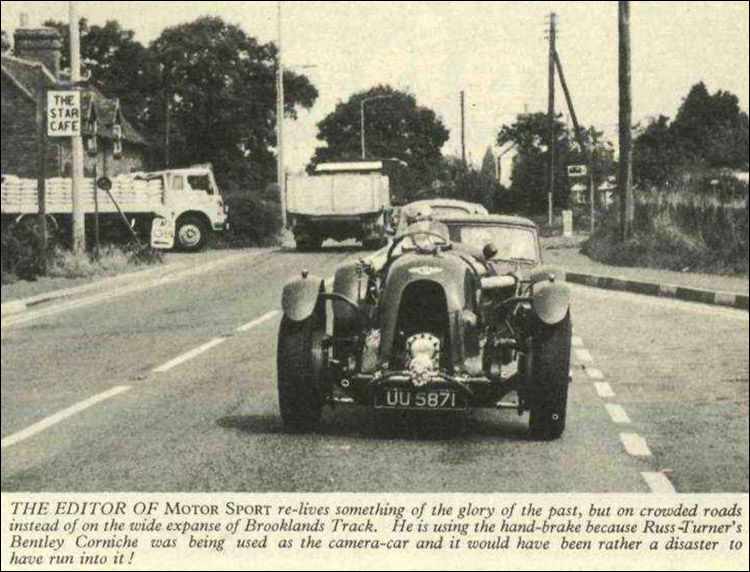Article: Driving the Ex-Birkin Blower-4½ Single-Seater Bentley (Page 6 of 8)
Extract from: Motor Sport, by William Boddy, October 1973
That was the last appearance of this very fast and successful Brooklands car. Birkin was estimated to have done more than 50 laps of Brooklands in it at 135 m.p.h. or more (I can count 11 official BARC race laps at this speed and 30 at over 130 m.p.h.) and had twice broken the lap-record with it, which he equalled on several occasions, when this was becoming a very difficult task. Sir Henry died in 1933 and surprisingly the Bentley was never raced again before the war, and Miss Paget either wouldn't, or couldn't, sell it. Sir Henry had said it was an extremely difficult car to drive fast so perhaps there were no takers.

In 1939, however, the late Peter Robertson-Roger blew up the engine of his ex-Birkin Pau 4½-litre at Donington and sought out the blower single-seater as a source of spares. He charmed the car's titled owner into parting with the car, which was towed away behind John Morley's Packard and a lorry-load of spares. A two-seater, long-tailed body, made by Chalmers of Redhill, was put on the chassis by Peter and John after the war and when Peter died in 1958 his will left the famous Bentley to John. "Rusty" Russ-Turner bought it and after using it for a while in this form, to his ever-lasting credit he refitted the track radiator, later put the single-seater body back on, and had the original radiator cowl repaired by Caffyns. He had to alter the cockpit somewhat, to accommodate his large frame, but the car looks very decently original and is on its original UU 5871 registration, which Morley had traced to a milk-float in Ireland! It is raced in VSCC, BDC, and other events and used on the road in its old Brooklands guise.
No-one could have been more fitted to acquire and restore the famous single-seater than B. M. Russ-Turner. As a youth I went to Brooklands by train and Austin 7 and he by bicycle and four-push-rod Salmson. We both worshipped the car and its intrepid driver and Rusty in later life owned many special Bentleys. He has spent a vast amount of time and money on restoring the blower-4½ track car and it was a great honour when he invited me to drive it, especially as he had spent the whole of the preceding week replacing yet another cracked block especially for the occasion.
When we arrived at his Sussex cottage in the BMW, there on the lawn was the car I had come down to drive and discuss and the other 4½-litre which now has the two-seater body which was on the single-seater when Rusty bought it and which he hopes soon to Supercharge. As the engine of the blower car needs much warming-up and this had been done, I lost little time in going out in it, paced, or more correctly shown the way, by Russ-Turner's open Bentley Corniche. Originally Birkin climbed in by placing a foot on a piece of fairing over the brake gear but a step has since been provided. The cockpit would originally have fitted me as it did Tim but now I needed a thin cushion behind my back. The four-spoke steering wheel is very big, so there were some gymnastics to get both legs beneath it. Seated, the long muchlouvred bonnet stretches purposefully ahead and you are confronted by a magnificent array of dials and controls.
The big Jaeger rev.-counter has pride of place, reading in steps of 500 r.p.m., from 500 to 6,000. To its right are the water and oil temperature gauges, with a pull-out knob below them which frees the reverse stop on the gear-lever should one need to travel backwards. To the left of the rev.-counter one finds the oil-pressure gauge, reading to 100 lb./sq. in., and the supercharger gauge giving a minus or suction reading on one side of the dial and the pressure scale, 0.3, 6, 9, 12 on the opposite side. Lower down or under this crowded dashboard, which by the way is the original and took a week to rub down, are a horn-push, Ki-gass, a hand throttle, and the glass-bowl oil drip-feed for the rear supercharger bearing. What looks like a direction-indicator control is used to test the dual magnetos. Outboard of this is the air pump for fuel feed, no longer used, as electric pumps were original equipment, and above this there is an ammeter, as a starter is now fitted. The smaller gauges are Smiths.
Continued on next page
